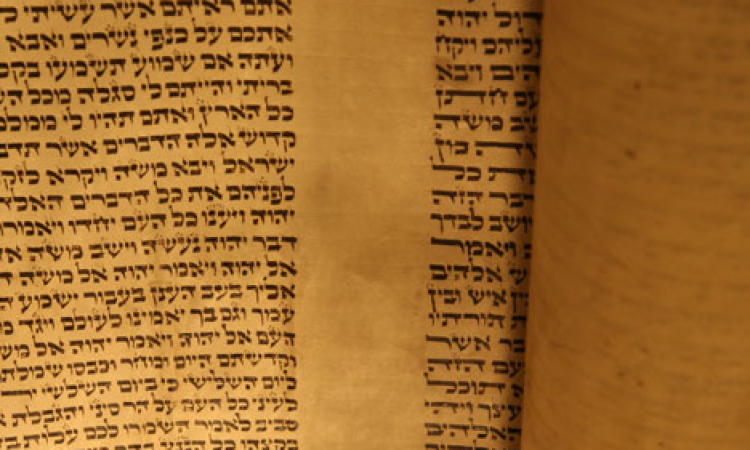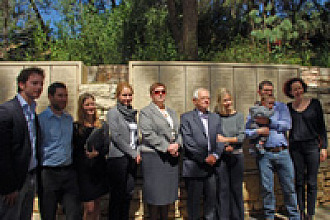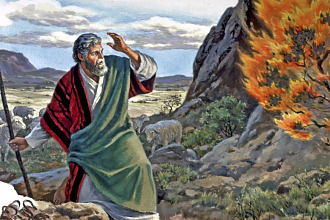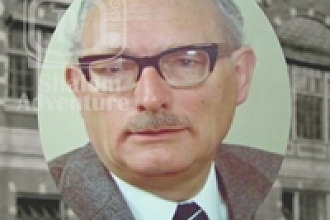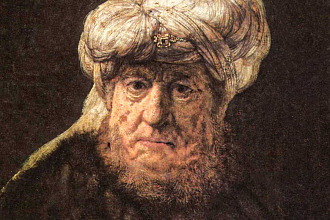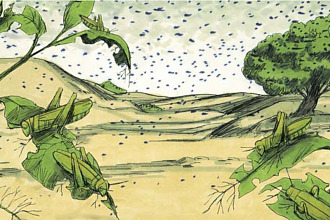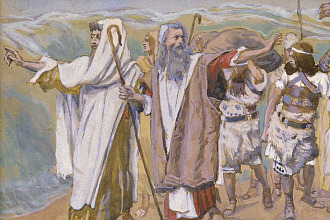Parasha for the Week: Vayakhel: Exodus 35:1 – 38:20
Aftarah for the Week: 1 Kings 7:13 - 51
Besorat Yeshua: Mark 15:42 – 16:6
Overview:
Moshe Rabbeinu exhorts Bnei Yisrael (children of Israel) to keep Shabbat, and requests donations for the materials for making the Mishkan. He collects gold, silver, precious stones, skins and yarn, as well as incense and olive oil for the menorah and for anointing.
The princes of each tribe bring the precious stones for the Kohen Gadol’s breastplate and ephod.
G-d appoints Betzalel and Oholiav as the master craftsmen.
Bnei Yisrael contribute so much that Moshe begins to refuse donations.
Special curtains with two different covers were designed for the Mishkan’s roof and door.
Gold-covered boards in silver bases were connected, forming the Mishkan’s walls.
Betzalel made the Holy Ark (which contained the Tablets) from wood covered with gold.
On the Ark’s cover were two figures facing each other.
The menorah and the table with the showbreads were also of gold.
Two altars were made: a small incense altar of wood overlaid with gold, and a larger altar for sacrifices made of wood covered with copper.
"Israel's Generosity"
The generosity of Israel is very famous and not a fake news, Jews were very generous for the Sanctuary, and continue to be very generous, we have just to live for a while among Jews, Orthodox Jews to discover that there generosity is almost with
Moshe was the representative of the national community. Each individual brought his gift to Moshe and thereby gave it to the community. These gifts were no longer the donor’s private property, but belonged to to the nation. Only from the national property was it permissible to build the Mishkan.
The generosity of the people of Israel toward the building of the Mishkan was so great that they gave much more than was needed. “The people bring much more than enough for doing the work that the LORD has commanded us to do” (Exodus 36:5). More than what was required for carrying out the mission assigned by G-d; as a result, Moshe announced, “Let no man or woman do anything more for the contribution for the sanctuary.” (Exodus 36:6). The Torah tells us that after this announcement, “So the people were restrained from bringing, for the material they had was sufficient to do all the work, and more.” (Exodus 36:6–7). So they were left with a surplus, this surplus was put aside for the Mizbeach (Altar), for Tsedakah (Charity) and remain consecrated for a similar purpose and was received by the representative of the sanctuary, the Kohanim (Shekalim 2:5).
Giving Tzedakah is one of the greatest mitzvot. In essence every good deed we do is a charitable act, for every mitzvah brings G-d’s blessings not only to the individual who performs the mitzvah, but also to the entire community.
Our sages teach us that if one lacks the financial means to help others, they should nevertheless help by volunteering to collect money for a charitable cause. Only the one who gives charity himself could encourage others to give as well. The Talmud tells us that, “Greater is the one who influences others to give than the one who gives.”
"Aron HaKodesh"
After describing the building of the Sanctuary and its furniture, the Torah states: “Bezalel made the ark of acacia wood. Two cubits and a half was its length, a cubit and a half its breadth, and a cubit and a half its height” (Exodus 37:1). There are two types of skillful artisans, said Rabbi Zelig Pliskin. The first type of craftsman is one who is able to picture new designs in his mind. His fertile imagination enables him to create original works of art. This, wrote Rabbi Shlomo Kluger, is what the present verse is expressing. “And to think thoughts,” that is, Betzalel had the ability to visualize entirely new artistic creations.
The second type is an expert in making fancy vessels with intricate designs though he may not be creative or original. After he sees what someone else has done, he learns to make similar things — perhaps even better than the original designer.
Bezalel has been chosen by G-d to lead the work of the sanctuary, he did not make every room and every furniture by himself but he led the team of workers to do everything according to the inspiration of the Ruach Hakodesh and the instruction of Moshe, but he made the Ark of the Covenant with his own hands, for it is the principal object for which the whole sacred Dwelling Place was erected.
According to a Jewish tradition reported in Berachot 55a, when Moses gave his order to Bezalel he reversed G-d’s order “Make and Ark and the vessels and the Mishkan.” But Betzalel replied to Moses, “Moshe, the way of the world is to build a house and then bring into it the vessels, but you told me to first make the vessels and then the Mishkan. Where will I put the vessels that I make? Perhaps G-d told you to make the Mishkan first and then the Ark and vessels.” Moses responded, “You are called Betzalel — (literally) “in the shadow of G-d”, for you knew precisely how to interpret G-d’s words as if you were there, in his shadow.”
"How do we Behave?"
Does our Behavior fit our Bible understanding? The Torah states: “And the entire congregation of the Children of Israel went out from the presence of Moshe.” (Exodus 35:20) Rabbi Eliyahu Lopian commented on this verse that it was noticeable that Israel were in the presence of Moshe as they were parting from him. If someone is at a bar, his behavior will be noticeable in the way he talks and walks. One can easily perceive that someone is drunk from his actions and speech.
Similarly, according to Rabbi Zelig Pliskin when someone seriously studies the Bible, it should be noticeable from the way he behaves that he has been studying the Bible. The Bible is meant to change a person, to impact his being as well as his behavior. This is what the verse expresses: everyone could tell from the elevated manner in which the people behaved that they had just come from Moshe.
Whenever we learn the Bible or when we have been in a Bible environment, it should be noticeable from our deeds and traits that we have been in a spiritual environment.
Haftara: 1 Kings 7:13 – 51
In the text of our parasha God asks Israel to continue to build the sanctuary, Moses choose Betzalel for all artistic work. “Then Moses said to the Israelites: ‘See, the Lord has called by name Betzalel son of Uri son of Hur, of the tribe of Judah; he has filled him with divine spirit, with skill, intelligence, and knowledge in every kind of craft, to devise artistic designs, to work in gold, silver, and bronze… ” (Exodus 35:30-3).
In parallel to this text from the Torah, the text of the Haftarah tells us how about four hundred eighty years after Betzalel, Solomon choose a Jew living in Tyre, Hiram, for his artistic talent with copper. He brought him to Jerusalem to achieve some of the work of the Temple: “King Solomon sent for Hiram and brought him down from Tyre. He was the son of a widow of the tribe of Naphtali, and his father had been a Tyrian, a coppersmith. He was endowed with skill, ability, and talent for executing all work in bronze. He came to King Solomon and executed all his work.” (1Kings 7:13-14). The Tanach helps us to identify this man, because in his time the king of Tyre was also called Hiram, we know that this king Hiram was very cooperative with Solomon and helped him to get the woods and stones he needed. This artisan was not king Hiram, but a Jew from the tribe of Naphtali, but according to the parallel text in the second book of Chronicles 2:14 he was from Dan, thus the rabbis have concluded that his father was from the tribe of Naphtali and his mother from the tribe of Dan. His father is called a Tyrian, just because he was living in Tyre. Abarbanel suggests that since his mother was a widow, Hiram was living in Tyre to comfort and support her.
The Parasha and the Haftarah made some interesting parallel because the tow construction, Between the sanctuary built by Moses and the temple built by Solomon. Moses choose Betzalel from the tribe of Judah and Oholiab from the tribe of Dan (Exodus 31:2, 6) and the Temple in Jerusalem was built by Solomon who was from the tribe of Judah with the help of Hiram from the tribe of Dan. The Midrash (Shemot Rabbah 40)said about these two tribes that the most exalted tribe was the tribe of Judah and the one the lest respected was the tribe of Dan (by the way this tribe was not listed in the list of the 12 tribes of the 144,000 in Revelation 7, it also an indication of its spiritual failure). However, God asked these two tribes to collaborate together to build the sanctuary and the Temple, even though the tribe of Dan has fallen in apostasy God wishes unity among his people; the most exalted tribe has to collaborate and to work with the less respected tribes of Israel.
The text said about Hiram that he was “filled with wisdom, understanding and skill to do any work in bronze” (1 Kings 7:14) the Jewish tradition affirmed that he had the same qualifications and qualities as Bezalel who built the sanctuary with Moses. Rashi defines his qualities in this way: “Wisdom is the knowledge one acquires from others; insight refers to the new ideas and deductions that one derives from analyzing and developing his prior wisdom; and knowledge in the context of building the Tabernacle, is Divine inspiration [Ruach Hakodesh]” (I-II Kings, Rubin Editions page 69).
Apostolic Writings: Mark 15:42 - 16:2
As we already explained, the Besorah of Mark (gospel of Mark) was written and read in parallel with the cycle of the parashot’s reading in synagogues. So in order to be in harmony with the parashot the early believers in Yeshua assumed that the two parashot, Vayak’hel and Pikudey, were read on the same week, and the same passage of the Besorah (Mark 15:42-16:20) was read with these two parashot. But from time to time (when there is a thirteen month in the year), the two parashot are read separately on two consecutive weeks.
Starting the parasha Vayak’hel, Moshe Rabeinu exhorts Israel to keep the Shabbat as a holy day: ‘These are the things that Hashem has commanded you to do. Six days work shall be done, but on the seventh day you shall have a Shabbat of solemn rest, holy to Hashem.’” (Exodus 35:1–2). It is not the first time that Moses reminds Israel the commandment of the Shabbat. This time it is just before explaining how to build the sanctuary to be sure that Israel will not break the Shabbat even for a holy work such as the building of the Sanctuary. The Ten Commandments are God’s moral laws for all humanity, that is why these laws are superior to any other law even the law to construct the Sanctuary.
This reminder of the Shabbat is in parallel with the text of the Besorah which tells us how Yeshua was strong in keeping the Shabbat. We are at the end of the Besorah, in the last chapters we have read about the trial of Yeshua, his crucifixion by the Romans, and his death. How can we say that this text is about the faithfulness of Yeshua concerning the Shabbat? Let’s remember that Yeshua died on Friday evening, and since darkness came upon Jerusalem, the Shabbat started at the time of his death. Since Yeshua had victory over the Devil, he had the right to go to heaven immediately but the text mentioned that he stayed in his tomb on the Shabbat day.
The beginning of this portion of the Besorah says that after the death of Yeshua, a righteous man, Joseph of Arimathea, who understood that Yeshua was a good man and did not deserved death decided to bury his body in his garden, maybe his own grave. “And when evening had come, since it was the day of Preparation, that is, the day before the Shabbat, Joseph of Arimathea, a respected member of the Sanhedrin, who was also himself looking for the kingdom of G-d, took courage and went to Pilate and asked for the body of Yeshua.” (Mark 15:42–43). This man is mentioned as a member of the Sanhedrin, that means he was present when yeshua was condemned, during all the trial he gazed at him, he heard him, and his conviction was established, Yeshua was innocent, nothing is wrong in this man. That is why even though the members of the Sanhedrin were against Yeshua, he took the risk to oppose everyone, and wanted to give to this man a decent sepulcher.
There was something special in the death of Yeshua, he died earlier than the other crucified: “Pilate was surprised to hear that he should have already died. . . And when he learned from the centurion that he was dead, he granted the corpse to Joseph.” (Mark 15:44–45). Joseph took the body of Yeshua and organized the funeral service: “And Joseph bought a linen shroud, and taking him down, wrapped him in the linen shroud and laid him in a tomb that had been cut out of the rock. And he rolled a stone against the entrance of the tomb.” (Mark 15:46). This evening was a double holy day for the Jewish people. It was the eve of the seventh-day Shabbat, and on this very night the feast of Pesach was to start. The first day of Passover was a day of strict observance of rest and Shabbat. Since Yeshua’s died on the eve of Shabbat, Joseph had no time to finish the burial, that is why it is written that “Mary Magdalene and Mary the mother of Joses saw where he was laid.” (Mark 15:47). They wanted to bury Yeshua in a proper way, with all the honor due to a righteous man, but they could not. The Shabbat was to start, they decided to wait for the end of the Shabbat and to comeback to give a good sepulcher to Yeshua. The Besorah of Luke says: “Then they returned and prepared spices and ointments. On the Sabbath they rested according to the commandment.” (Luke 23:56). Nothing in the teaching of Yeshua was an allusion of canceling this commandment. The disciples of Yeshua were faithful Jews.
In the next verse of the Besorah we are on the first day of the week (Mark 16:1) that means on Sunday morning. Nothing is written about this Shabbat. Why? Because it was Shabbat, even though Yeshua was recognized as the Lord, even though he was the Mashiach expected by the Jewish people, he respected the Shabbat in his death. Neither him or His father in heaven did any work on the Shabbat. Indeed, to raise again is a work. Yeshua waited for the end of the Shabbat to accomplish this great action of coming back from the dead. This is a strong argument about the keeping Shabbat even after the death and resurrection of Yeshua. The resting of Yeshua in the tomb on Shabbat helps us to understand: “Do not think that I have come to abolish the Law or the Prophets; I have not come to abolish them but to fulfill them. For truly, I say to you, until heaven and earth pass away, not an iota, not a dot, will pass from the Law until all is accomplished.” (Matthew 5:17–18). Yeshua did not come to destroy the law of G-d, or to cancel it, or to change it, Yeshua is the new Moses, and as so, confirmed the law given by Moses to his people, that is why he confirmed the law and rested in the grave on Shabbat. The first verse of chapter 16 says: “But on the first day of the week, at early dawn, they went to the tomb, taking the spices they had prepared.” The women went to the tomb of Yeshua to continue the process of burying him, they did not expect at all that Yeshua would raise, that is why they came on the morning of the first day. However, that does not means that Yeshua raised from the dead on the morning, they have just discovered that he was not anymore in the tomb. In fact Yeshua was free to raise right after the Shabbat, we know through the teaching of the Bible, that Shabbat started at sunset on Friday and end at sunset on Saturday, that is why it is very possible that the resurrection of yeshua took place on Saturday just after the Shabbat.

